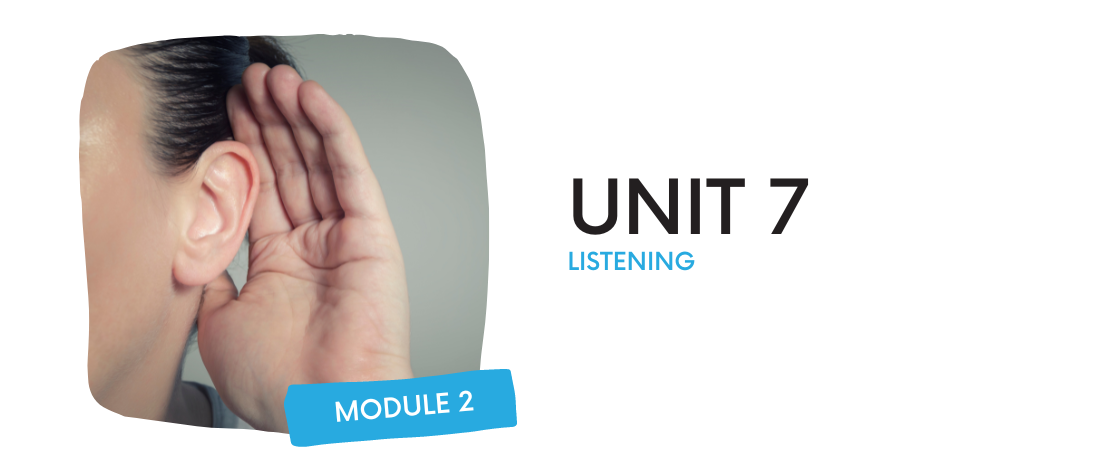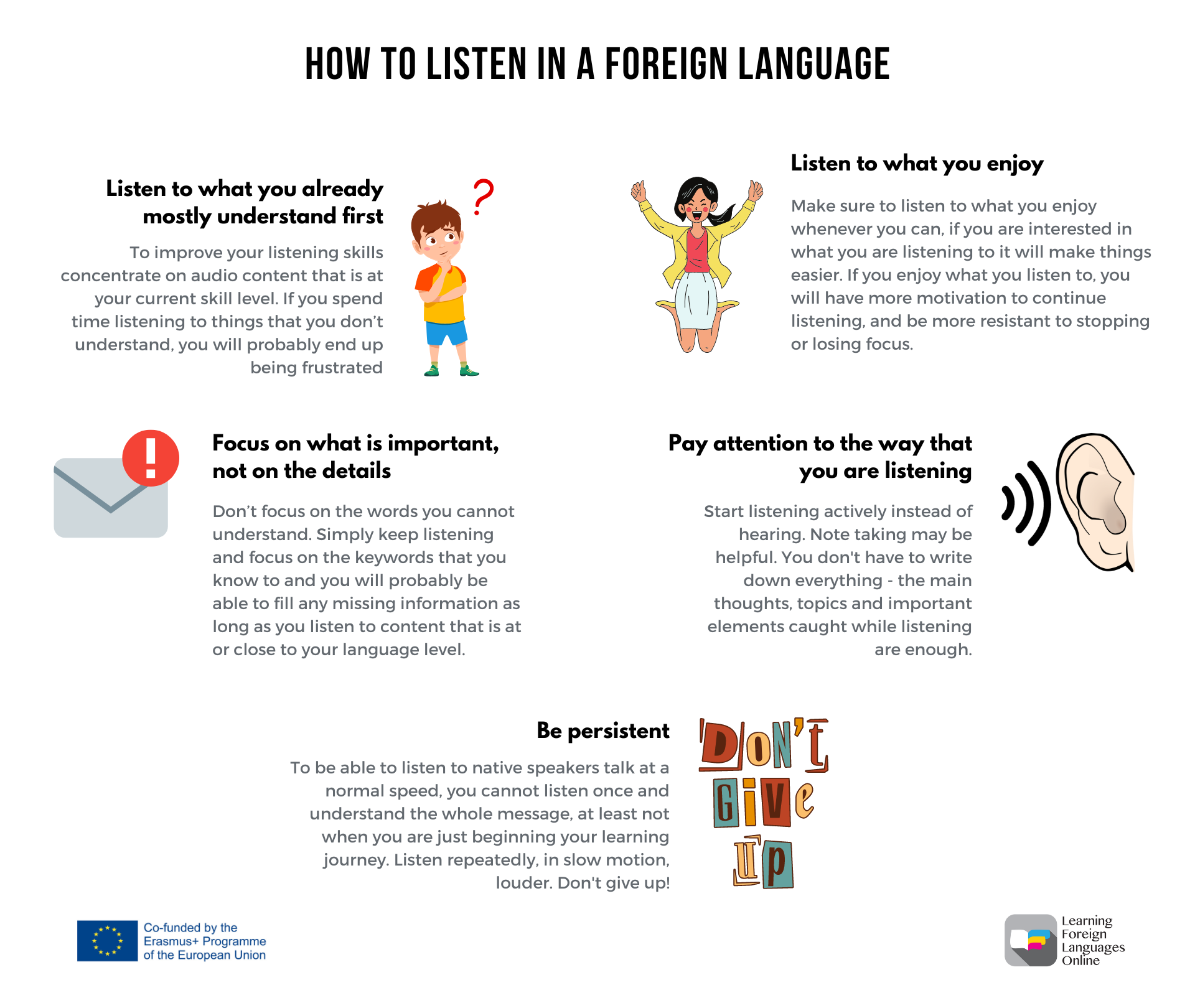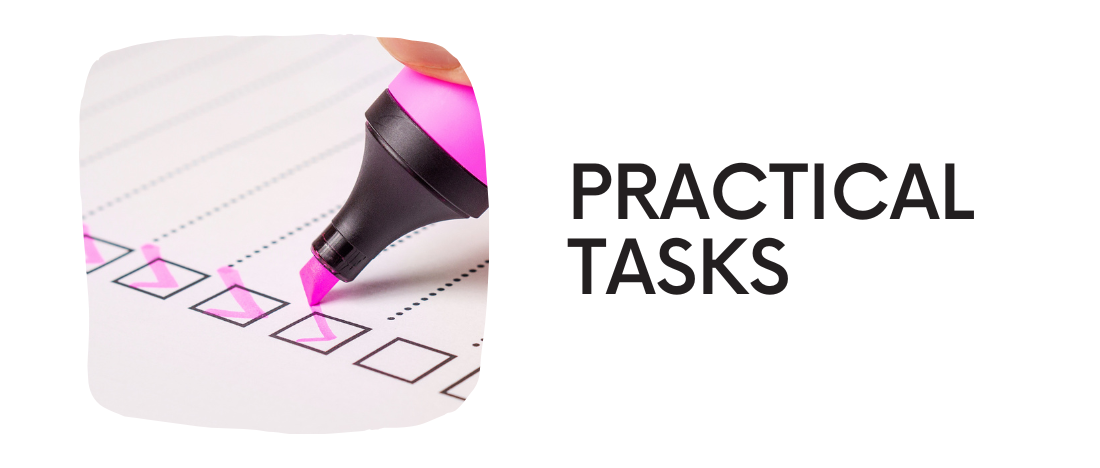
E-course
Listening
Module 2 | Unit 7
Introduction

What’s the difference between listening and hearing? You can hear a sound, a voice, but you listen to a conversation, words. Hearing is passive action, while listening is an active action. As you can imagine, listening is the ability to understand the meaning of the words that you hear and connect them with meanings and ideas. Listening means your brain is working in a very active way. Therefore, listening is an important part of the way to learn a new language.
Listening is a complex process because it involves many different parts of language, such as vocabulary, syntax, morphology, and pragmatics.
Listening helps you to build more knowledge, identify and anticipate problems, understand important points in a conversation, resolve conflict and build new, strong relationships.
It may seem like a hard task at first but doubtlessly, practicing and improving this skill is totally worth it.
Getting started

Tips

1. Listen to what you already mostly understand first.
To improve your listening skills concentrate on audio content that is at your current skill level. If you spend time listening to things that you don’t understand, you will probably end up being frustrated. However, if you listen to something that you mostly understand, you will understand the general content and meaning. It is easy to find different audio content that you are interested in and that will motivate you. Try to find real, authentic materials because it allows you to get yourself accustomed to different accents native speakers have and that you have to learn to understand in order to communicate efficiently. If you are spending time in a country where people speak your target language, listen to conversations people have while they are ordering in a restaurant, buying tickets, or groceries. While listening to all of these different materials you will probably encounter some words you don’t know yet and this will give you a chance to learn them. That will keep you motivated and will not make you feel frustrated.
2. Listen to what you enjoy
Make sure to listen to what you enjoy whenever you can, if you are interested in what you are listening to it will make things easier. If you enjoy what you listen to, you will have more motivation to continue listening, and be more resistant to stopping or losing focus. Interest is a state of psychological engagement, a state in which we engage with ideas, people and events. Our interests push us towards something new, different and exciting. They keep us focused on what is important to us instead of dispersing our energy and attention on all the different information that is available to us. Scientists have even proven that when we learn about what interests us it can help us overcome our listening difficulties and challenges we perceive we could never overcome. This is called appreciative listening. Appreciative listening is when you enjoy what is being said by the speaker. You are personally interested in what is said but it does not have to be necessarily a conversation. This can also happen when listening to music or a podcast. You appreciate what you hear because you really like it.
Make sure that most of your practice time is spent with audio materials that match up well with your goals and interests.
3. Focus on what is important, not on the details.
This is important because if you don’t focus on what you are listening to, you may miss the important message that is being communicated. Don’t focus on the words you cannot understand, the words you already know will help you to understand the context. Simply keep listening and focus on the key ideas of what you are listening to and you will probably be able to fill any missing information as long as you listen to content that is at or close to your language level. This is called informational listening meaning, to listen with the goal of learning, understanding and grasping information. It is a more passive form of listening because you don’t listen to judge or to evaluate you just have to listen to understand what is said.
4. Pay attention to the way that you are listening
To get maximal value from your listening activities, you need to turn passive listening into active listening, so you need to move from hearing towards listening. One of the best ways to do this is by taking notes while you are listening. You can write down the topic of the audio, write down the names of the speakers, include the main points they try to communicate, and if you frequently listen to a word that you don’t understand, you can write it down, so you can look it up later.
Passive listening is listening without reacting to what you hear. If you are passively listening to someone or something it means you are not doing anything else at the same time, but you are not really engaged with the information you are receiving, you are not thinking about it, analyzing it or paying enough attention to what is being said.
Active listening means that you are focused on what you are listening to, it can be something a person is saying to you in a conversation, a dialogue in a movie or a tv show, or even the lyrics to songs, which we normally listen to passively. When you are listening passively you give your full attention to the content, and you have no distractions. In active listening, your brain and senses are fully active. You analyze what is being said and try to create an outline in your mind of the most important points of what you are listening to. The next step is to begin with critical listening.
Critical listening is a process for understanding what is said. You evaluate, judge and form an opinion on what you hear. You have to evaluate the content, decide on the pros and cons of it, agree or disagree with the information you are listening to and analyze the most important points of it.
After you have put into practice these different listening styles, have in mind that different situations in life require different listening styles.
5. Be persistent
To be able to listen to native speakers talk at a normal speed, you cannot listen once and understand the whole message, at least not when you are just beginning your learning journey. The speed of speaking and the extensiveness of your vocabulary play a factor in understanding a message correctly. Because of this, you will likely need to listen at a slower pace, dedicate time to concentrating on listening at more comprehensible speeds first, before you can gradually understand speech at normal speed.
For any language routine to be successful, it needs to keep you interested. You need to be engaged in a variety of different activities that challenge you and make you want to keep learning day after day. Try reading a transcript of the audio or choose another audio to keep you motivated. Basically, do not settle to doing tasks and activities you are comfortable with, find new and exciting exercises that will motivate you to listen and relisten to the same audio material. We know listening to the same thing over and over again can get boring and may seem unnecessary, but it is the only way to get the most out of the materials you use and definitely a great way to learn new vocabulary and get used to the spoken expression of your target language.
Listening skills take time to grow and develop. They depend on a wide variety of factors (time spent learning, amount of listening done, and knowledge of vocabulary). The only way to improve your listening skills is to be consistent. If you can maintain such a routine for months, or even years, you will soon find that your listening comprehension has grown exponentially.

QUOTES
• “It’s not hearing that improves life, but the listening” Mihaly Csikszentmihalyi (psychologist)
• “Do not listen with the intent to reply, but with the intent to understand” Steven Covey
• “Most of the successful people I’ve known are the ones who do more listening than talking” Bernand Baruch
More resources

Still want to continue learning about the topic of this unit? Not to worry, we have made a selection of further resources that you can use if you would like to find out more. Just click on the links and keep learning!
Practical tasks

 Choose a video from YouTube, less than 2 minutes, in your target language, make sure it has subtitles in the language you are learning. Hit play and listen to it for a little while, then hit pause, and try to repeat what you have listened to. You can use different speeds and have a great time deciding which listening speed is right for you at the moment. Try to repeat what the listener is saying, have fun pronouncing the words slowly at first and then faster. This task helps you to improve your listening, memory, and pronunciation.
Choose a video from YouTube, less than 2 minutes, in your target language, make sure it has subtitles in the language you are learning. Hit play and listen to it for a little while, then hit pause, and try to repeat what you have listened to. You can use different speeds and have a great time deciding which listening speed is right for you at the moment. Try to repeat what the listener is saying, have fun pronouncing the words slowly at first and then faster. This task helps you to improve your listening, memory, and pronunciation.
 Choose material that is in the form of a story. You can choose a recording of a fictional book, a children’s story, a chapter from an audio book, whatever you are comfortable with. The first thing you should do is listen to it at the appropriate speed to understand the gist. After the first listen, play it again to gain specific information.
Choose material that is in the form of a story. You can choose a recording of a fictional book, a children’s story, a chapter from an audio book, whatever you are comfortable with. The first thing you should do is listen to it at the appropriate speed to understand the gist. After the first listen, play it again to gain specific information.
List simple information first. Write down the names of the protagonists, then of the antagonists. The next thing you should do is sequence the events of the story. Write down five main plot points.
There are other things you can do with the same material. Write down all questions you hear, if it’s a children’s book that involves magic and fantasy characters you can write down how magic changes the events of the story. Write down all the colors and numbers you hear. Write down the adjectives with only positive connotations (happy, wonderful, etc.).
 Choose a song in your target language, one that you like and that makes you feel positive, and listen to it a few times during your daily routine, then look for the lyrics and compare if what you are singing is similar to the actual lyrics of the song. Did you do well? Now, learn the lyrics and try to sing it properly this time. Follow this task every time you find a new song in your target language. This is not only helpful but a fun way to learn new expressions and phrases.
Choose a song in your target language, one that you like and that makes you feel positive, and listen to it a few times during your daily routine, then look for the lyrics and compare if what you are singing is similar to the actual lyrics of the song. Did you do well? Now, learn the lyrics and try to sing it properly this time. Follow this task every time you find a new song in your target language. This is not only helpful but a fun way to learn new expressions and phrases.
 Choose one fairytale video on YouTube, the one you know well, quite brief and easy. If you have kids or nephews, then make it together. You will have a great time! Now, listen to it and on a paper divided into strips, draw the actions you hear. Draw simple and funny characters. You will practice active learning by doing this activity.
Choose one fairytale video on YouTube, the one you know well, quite brief and easy. If you have kids or nephews, then make it together. You will have a great time! Now, listen to it and on a paper divided into strips, draw the actions you hear. Draw simple and funny characters. You will practice active learning by doing this activity.
 Choose three podcasts on a topic that you are interested in, each should last for at least five minutes. After you have listened to them retell using five sentences each of the podcasts, summarize the main ideas and what has been said in the podcast. If you are at a higher learning level and the podcasts you have chosen are thematically relevant to something you are interested in or passionate about you can write five things you agree/ disagree on with the speakers of the podcast.
Choose three podcasts on a topic that you are interested in, each should last for at least five minutes. After you have listened to them retell using five sentences each of the podcasts, summarize the main ideas and what has been said in the podcast. If you are at a higher learning level and the podcasts you have chosen are thematically relevant to something you are interested in or passionate about you can write five things you agree/ disagree on with the speakers of the podcast.
Unit test

